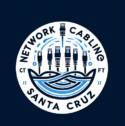Which Cable Is Used Mostly in Making a Network?
If you’ve ever wondered which cable is used mostly in making a network, the answer depends on the type of network and its performance needs. In most modern installations, Ethernet cables — specifically CAT6 and CAT5e — are the most widely used because they’re reliable, affordable, and support high-speed data transmission. Whether you’re setting up a home Wi-Fi system, a business network, or a data center, the right cabling makes all the difference in speed, stability, and scalability. Our team of structured cabling professionals in Santa Cruz ensures that every network setup is efficient, organized, and built for long-term reliability.
The Most Common Cable Used in Networking
The most commonly used cable in network setups today is the Ethernet cable, part of the “Category” family of twisted-pair cables (CAT5e, CAT6, CAT6a, and CAT7). These cables are designed to connect computers, routers, switches, and other network devices.
Here’s a quick overview of the most popular types:
- CAT5e (Category 5 Enhanced): Supports up to 1 Gbps speed and is commonly found in homes and small offices.
- CAT6 (Category 6): Handles speeds up to 10 Gbps at shorter distances and reduces interference.
- CAT6a (Augmented Category 6): Enhanced version of CAT6 with improved shielding and longer range for 10 Gbps speeds.
- CAT7 and CAT8: Used for high-performance data centers and enterprise-level networks requiring extremely fast transfer rates.
Among these, CAT6 cables are currently the most used in new installations because they strike the best balance between cost, performance, and future readiness.
Why Ethernet Cables Are So Popular
Ethernet cables dominate the networking world because they provide:
- High-speed connections for smooth streaming, gaming, and file transfers
- Low interference, thanks to twisted-pair design
- Easy installation and compatibility with existing hardware
- Affordability compared to fiber optics
- Reliability over Wi-Fi for consistent performance
This combination of benefits makes Ethernet the go-to choice for both residential and commercial networks.
How Ethernet Cables Work
Ethernet cables transmit data using copper wires arranged in pairs that carry electrical signals. Each pair is twisted to minimize interference (crosstalk) from neighboring cables or devices. The cable connects directly between devices — like a computer and router — allowing fast, direct communication without relying on wireless signals.
In structured cabling systems, Ethernet cables are typically installed inside walls, ceilings, or conduits and terminated at network jacks or patch panels. This setup creates a clean, organized, and reliable network structure.
Fiber Optic Cables: The High-Speed Alternative
While Ethernet cables are the most common, fiber optic cables are gaining popularity for high-speed and long-distance applications. Instead of copper, fiber uses thin glass or plastic fibers to transmit data as light signals, offering:
- Faster speeds (up to 100 Gbps or more)
- Longer distances without signal loss
- Resistance to electromagnetic interference
Fiber optics are often used in data centers, large businesses, and internet backbones across California and beyond. However, for everyday home and office use, CAT6 Ethernet cables remain the practical standard.
Choosing the Right Cable for Your Network
The best network cable depends on your environment, usage, and budget. Here’s a simple guide:
- Home networks: CAT5e or CAT6 is ideal for internet, streaming, and gaming.
- Small to medium businesses: CAT6 or CAT6a provides strong performance and scalability.
- Enterprise and data centers: CAT6a, CAT7, or fiber optics for maximum speed and bandwidth.
- Outdoor or industrial environments: Shielded CAT6 (STP) or fiber cables for durability and protection.
When in doubt, consult a professional network cabling installer to help design the best setup for your needs.
Common Mistakes When Choosing Network Cables
Avoid these common cabling mistakes that can hurt performance:
- Using low-quality or counterfeit cables
- Mixing incompatible categories (like CAT5e with CAT7 components)
- Ignoring distance limits (CAT6 maxes out at 55 meters for 10 Gbps)
- Poor cable management or inadequate labeling
- Failing to test connections after installation
A well-planned cabling system ensures stable, fast, and future-proof connectivity. While some cables are favored for speed or cost, others are preferred for safety. Learn what type of cabling is the most secure for networks to understand which option best fits your setup.
The Future of Networking Cables
As data usage continues to grow, so does the need for faster and more reliable cables. The next generation, CAT8 cables, supports frequencies up to 2000 MHz and speeds up to 40 Gbps — perfect for high-end data centers and advanced business networks.
However, for most homes and offices, CAT6 and CAT6a will remain the standard for years to come due to their wide compatibility and cost-efficiency.
Final Thoughts
So, which cable is used mostly in making a network?
The answer is Ethernet — specifically CAT6. It’s the perfect blend of speed, affordability, and reliability for most network installations today. If your goal is faster data transfer, you’ll also want to know which cable is used for high-speed internet to get the best performance possible.
Whether you’re building a new network in California or upgrading your existing one, investing in professional CAT6 cabling installation ensures your setup runs smoothly, efficiently, and is ready for the future.
